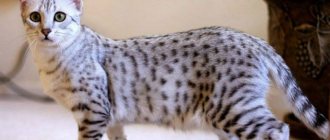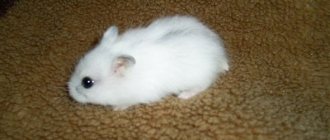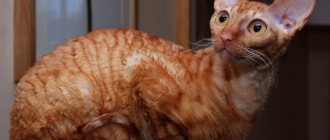What care is needed
Bengal cats are very clean: they take care of themselves and keep their place clean. Keeping Bengals is within the power of every owner; for this, the basic rules should be followed:
- Introduce a feeding regime, accustom the animal to a certain routine: food, play, walks, sleep.
- Provide animals with high-quality store-bought food or cook it yourself.
- Buy a scratching post and immediately teach the kitten not to damage the furniture.
- Care for the fur: comb it once a week and treat it with a furminator.
- Clean from helminths once a quarter.
- Bath with shampoo once every 3 months, and unscheduled before an exhibition or when dirty.
- Walk on a harness in the fresh air.
- Clean ears from wax and dust.
Like all cats, Bengals love to catch mice, which are a source of infection. To avoid infection, when your pet brings prey, you should praise it and quickly get rid of the rodent.
Ear and dental hygiene
Complete care for a Bengal kitten includes cleaning the eyes, ears and brushing the teeth. The ears are examined regularly. If sulfur plaque is noticed, it is removed using cotton swabs soaked in Vaseline oil. You can use ear drops for this. The inner surface of the ears is wiped with hygiene cream or Vaseline.
You should definitely brush your teeth at least once a week. Special toothbrushes and toothpastes are produced for cats. Bengals, like people, suffer from diseases such as caries, tartar, and periodontal disease. If there is an unpleasant odor from the face, plaque on the teeth, or bleeding, you should show the animal to a veterinarian.
Bathing and brushing
Bengals are a smooth-haired cat. Therefore, caring for their coat and skin is quite simplified. Bathing is carried out once every 3 months. When contaminated, it is allowed more often. All “leopards” love water very much and bathe with great pleasure. You can bathe or wipe your cat with special compounds for short-haired breeds:
- grooming spray with protein and mink oil;
- conditioning balm with protein and mink oil.
Brush the meowing creature no more than once a week. Start with the head, then the back.
They end with the tummy and paws. First, the comb movements are carried out against the growth of the smooth short fur, then in the direction of growth. Using a rubber glove, remove fallen hairs. Before combing, you can thin out the fur with a furminator.
Care
Providing complete care for a breed called a Bengal cat is a whole set of recommendations that need to be taken into account. Knowing how to care for a Bengal kitten from a young age, you will not worry about the health of your pet in the future (for example, the risk of allergies will noticeably decrease). What rules are required to be followed?
Behind the ears
Care and maintenance of your Bengal begins with regular cleaning of the ears. They often accumulate dust and sulfur, which must be removed in a timely manner. To do this, use ear sticks that are pre-moistened in a special solution. Do this procedure regularly, and the health of your Bengal's ears will be in perfect order.
Catering rules
Until the age of one month, babies, as a rule, are fed only breast milk. After 4–5 weeks, new foods begin to be introduced into the diet. This could be a scraped chicken breast, scalded with boiling water. A little later it will be veal, beef or turkey cut into small pieces. Add porridge with eggs to your diet. Be sure to include raw and boiled vegetables: carrots, pumpkin, beets, broccoli, cauliflower.
Keep in mind that at the age of 8–9 months, a cat’s weak point is the stomach (diarrhea often occurs). Experts recommend feeding animals very carefully and choosing premium food:
The packaging must indicate that the food is intended for feeding kittens. Pay attention to the age recommendations on the packaging. Some kittens have individual intolerances and skin allergies - in this case, purchase hypoallergenic formulations.
Consider the physical activity of Bengals. For neutered cats with a tendency to obesity, low-calorie recipes are suitable. Try not to give such economical options as Felix and Whiskas.
There should always be fresh water in the bowl, which should be changed 1-2 times a day.
What proponents of natural nutrition should know:
- 80% of the diet should be meat, the best option is beef without fat.
- 10–15% – edible bones: neck, joints, cartilage (except tubular).
- 5–10% – tripe: chicken heart, stomach, lung.
- You can also give chicken, rabbit, and veal as meat.
- The meat is first frozen and served raw.
- You can sometimes feed them boiled pieces.
- Liver is given rarely and little by little.
- Pork and lamb are prohibited for Bengals.
- You cannot offer hot or cold food.
- Cats are given boiled, boneless sea fish; cats do not need fish.
- Healthy dairy products include kefir, fermented baked milk, and cream.
To breed “little leopards” and have healthy offspring, take care of vitamins and minerals. A veterinarian will help you make the right choice.
What you need to know about parenting
Bengal kittens are smart little ones who remember everything well. If you take care of them and educate them, they grow up obedient and neat. Their upbringing is not particularly difficult.
Like all babies, they are trained to use a tray. To avoid incidents and the little ones do not disdain the toilet, the wood filler is constantly replaced. “Leopards” love to rummage and bury their deeds, so they need a toilet with high sides.
You can exercise with kittens using toys. This develops their attention and motor abilities. Useful:
- rustling and buzzing toys;
- swingers, balls, marbles;
- tunnels and hide and seek around the corner.
Kids will be busy and less likely to look for entertainment on curtains and carpets. Bengals love to play with children and make great friends.
Do Bengal cats catch mice? This is a pressing question for owners of private houses. They are excellent hunters, so they will never let a single rodent pass by. But they are eaten very rarely.
Be sure to teach your pets the “No!” command. To make the process more effective, pinch the pet’s neck while pronouncing the command. This should be done without effort, lightly, as mother cats do.
You can only walk outside with a vaccinated, healthy animal. For walks around the city, it is important to teach your Bengal to walk on a leash. After petting the pet, they put a collar on it that protects it from parasites. The collar is not removed on the street, as the animal may run away due to excessive curiosity and it will be extremely difficult to find it.
Conditions of keeping: how to arrange a comfortable stay for a Bengal cat in the house
Household items that are truly vital for Bengal cats include:
- separate bowls for food and water;
- a lounger-bedding or a box - a house, you can use a spacious basket;
- a toilet in the form of an open tray or a closed structure, with filler in it (it happens that a cat does not go to the tray, preferring the toilet);
- toys in a wide range of sets - sticks, balls, artificial rodents, a running wheel, ideally a play complex is desirable, various houses - Bengals have an increased need for active games;
- scratching posts preferably of two types - with hard and soft structures (wood, cork, rope, bark).
Also, from time to time a special carrying box or bag for transportation is required.
Special devices
Scratching posts help save the decor and interior of the house from the claws of domestic predators. Even if the pet is walking outside, in the apartment he will sharpen his claws several times a day. When choosing an accessory, pay attention to:
— stability, structural strength;
— quality of materials, functionality;
— a height sufficient for an adult animal: a Bengal cat actively stretches its body to grasp with its claws.
Since Bengal cats like to scratch surfaces at different angles, it is more rational to install several scratching posts - vertical (this one can have a resting area at the top), wall-mounted, horizontal.
What types of harnesses and collars are there?
Collars are purchased for different purposes - therapeutic and prophylactic and for walking, decorative for aesthetic purposes, and informational - so that a lost animal finds its home again. Nowadays special harnesses are produced for walking.
Walking harnesses are leashes of a special design that are preferable to a collar due to their safety for the animal. The cat's neck will not slip out of such a leash, and the danger of getting caught on anything is eliminated. Various designs distribute the load and do not put pressure on the pet's throat. Walking harnesses are:
— V-shaped, when the connecting bar of the loops falls on the cat’s chest;
- H-shaped, in which the bar rests on the back;
- in the form of two loops connected by a figure eight;
- in the form of a vest - such designs also allow you to protect the cat’s fur coat from dust, precipitation and dirt in some places.
Owners can choose soft leather, light cotton, durable, practical nylon harnesses.
How to raise a Bengal kitten
The socialization of the little Bengal begins almost from birth. He learns to interact with his mother cat and his brothers and sisters, equally inexperienced babies. After some time, people fall into his circle of interests. Experienced breeders perform a procedure called handling, accustoming baby Bengals to human hands.
The kitten is carefully and extremely carefully picked up and held for some time. Tactile sensations received at an early age are perceived by the pet as pleasant and natural. This is one of the reasons why purebred kittens react much calmer to human contact, unlike stray kittens.
A good tip on how to train a Bengal is to continue to handle it frequently with your new family. This practice will help you quickly make friends with your pet. Despite the presence of wild blood, Bengals are very friendly and sociable. If a kitten is raised correctly, a situation where it does not go to hand should not arise.
Description of the abilities and character of a Bengal kitten:
| Need for communication and attention | Very high |
| Attachment to the owner | High |
| Ability to get along with children | Very good |
| Ability to get along with other pets | Good, but there are problems with birds and rodents that become targets for hunting |
| Need for physical activity | High |
| Intelligence level | High |
| Relation to water | Usually very positive |
| Learning ability | Tall, can learn to fetch a toy and use the toilet |
The breeder knows how to raise a Bengal kitten. He will have to work hard to instill the right habits. The pet learns to eat solid food and drink from a bowl. He is being toilet trained. By three months, the animal is completely ready to move to a new home, but this does not mean that the new owner can relax and reap the benefits of upbringing that the new family member received earlier. We will have to solve several problems:
- prepare housing for the kitten's arrival;
- alleviate stress;
- maintain acquired skills;
- correct the kitten’s behavior;
- teach the kitten the “no” command.
The kitten grows, its behavior changes. There are stress factors that are not obvious to people, but are significant for a cat. We must not forget about temperament, which influences behavior. What to do in this case? Experienced breeders recommend continuing training; the results will appear over time.
Bengals are very musical cats. At an early age, they begin to sing and scream to express their feelings. If the owner is confident that the kitten is fed and healthy, it may simply need attention and comfort. To calm your pet, it is enough to pick him up, hold him, and warm him.
Vitamins and vitamin treats
Vitamins play a big role in the development of pets, their health and well-being. Vitamins not only increase the intensity of physiological processes occurring in the cat’s body, but also support the immune system, which protects against negative environmental influences.
In addition, vitamins increase resistance to infectious diseases, and during illnesses contribute to rapid recovery. The absence or insufficient amount of vitamins in a cat’s body can lead to disruption of the most important functions. Unlike proteins, fats and carbohydrates, a cat’s body does not require a large amount of vitamins, but even in small doses they can have a beneficial effect on the growth, metabolism, development and reproduction of cats. Vitamins also strengthen the body's muscles, bones and circulatory system. A lack of vitamins leads to vitamin deficiency and other diseases that cause discomfort and affect the behavior of cats.
We use Omega vitamin treats
3. Deworming
For preventive purposes, it is recommended to treat worms once every three months. For deworming, I recommend using combined-action drugs (for cystodes and nematosis).
Tablets, for example, Kanikvantel+, Dirofen.
For me it is more convenient to use drops on the withers. I recommend alternating Profender and Stronghold drops.
First days in a new house
A responsible owner begins preparing for the kitten's arrival in advance. Must have:
- bowls;
- toilet;
- feed;
- filler;
- house;
- cosmetical tools;
- grooming brush;
- toys;
- contacts of an experienced veterinarian;
- stocked first aid kit.
Young mini-leopards are inquisitive and nimble creatures. Even on the first floor, all windows must be covered with bars to prevent the pet from escaping. Cables of any kind must be hidden in boxes, under the baseboard, i.e. move away from the kitten as far as possible.
When a little Bengal is brought to a new home, the owner’s actions must be clear:
- Pour the food recommended by the breeder into a bowl.
- Pour fresh and clean water.
- Place litter in the toilet and add some old litter (obtained from a nursery) so that the kitten recognizes its smell.
- Place the carrier on the floor and open it.
- Move a reasonable distance away.
- Wait until the kitten leaves the carrier.
- Allow him to explore the house on his own.
- Make sure he eats and drinks from new bowls and goes to the toilet.
Only after this can you carefully approach the kitten, establish the first tactile contact, and try to stroke it. The desire to immediately grab your treasure, shower him with kisses, scratch him behind the ears is quite understandable. But such behavior can only scare the Bengal and increase stress.
Toilet problems: causes and solutions
Even if the adaptation process at a new place is carried out according to all the rules, this does not guarantee the absence of problems. Often the kitten refuses to use the litter box. An animal can choose a variety of places to perform its natural needs: a corner behind the toilet, surfaces covered with fabric (upholstered furniture), a shower tray.
If the pet chooses all unauthorized places for the sake of privacy, it means that using the existing tray causes discomfort or stress. Some purebred kittens prefer to use a toilet in the form of a house; an open litter box is not suitable for them. You need to purchase a new device, fill it and add some old litter from the previous tray so that the kitten can smell its own scent.
Sometimes the litter is not suitable for a Bengal cat baby. Many breeders recommend choosing woody or other “rustling” options for litter box training. Not all kittens like the helium version, although it is more convenient to use. One more thing - Bengals are amazingly clean. The filler must be replaced after each visit. Some owners provide the kitten with two litter boxes at the same time. To find the right filler, you will need to experiment.
Another reason why a kitten shits in the wrong place is the desire to mark territory. This is a character trait that will take a long time to fight, and success cannot be guaranteed. Experienced Bengal owners advise getting rid of upholstered furniture that does not have removable covers in advance, or purchasing such covers in advance. Medical mattress covers or other absorbent materials are placed under them to protect the furniture from getting wet.
It happens that an adult cat stops marking her territory and begins to use the litter box regularly, but then the problem arises again. The point may be that the animal has already marked everything it wanted. The owners washed the furniture from dirt and got rid of the characteristic smell. Weak cat vibes remain, the cat feels them, but the person does not.
Profile online communities are full of advice from experienced cat lovers, but their effectiveness may be questionable. Here are some interesting recommendations that helped to train a kitten to the toilet:
- lubricate areas prohibited for defecation with orange or lemon essential oil; cats do not like the smell of citrus fruits;
- use vinegar or a special spray for the same purposes;
- monitor the kitten and at the first sign put it in the tray;
- reward with a treat for each successful visit to the toilet;
- wash the “wrong” place with a cleaning agent, put food there, cats don’t shit in the places where they eat.
How to educate and toilet train
Raising these feline babies is an important process for their owner. First of all, the kitten needs to be toilet trained. This is not always easy to do, since these creatures are so squeamish that they sometimes refuse to even visit their litter box. To avoid this problem, buy wood filler for the toilet. If even after this the “Bengal” does not want to go to the litter box and relieves himself in another place, sprinkle the surface with table vinegar or citrus fruits, and your pet will not appear there again.
Raising your tailed pet is simply necessary. Spend more time with him as he has a very playful personality. It is important that the “Bengali” has his own toys, otherwise he will catch and start having fun with everything he comes across, right down to your clothes.
Remember: it is necessary to teach the cat the “No!” command in a timely manner.
To do this, first combine a verbal command with lightly pinching the kitten's neck. However, do not try to hit him - violence will not help your pet understand what you want from him. When walking, try to put a harness around the cat's neck. You need to accustom him to a leash from an early age, then he will not behave nervously during walks.
How to punish correctly
Education must be consistent. If you can’t climb onto a table in the kitchen, then this rule should be extended to all tables in the house. Cats do not understand human logic; for them there is no difference between a kitchen table and a computer table. Hard training is unacceptable; attention and a lot of patience are required.
Any violence: hitting, shouting, poking your nose at the Skoda when training a kitten is completely unacceptable. Screaming is useless; such tactics can seriously harm and completely destroy the trust between owner and pet. The punishment should be understandable to the kitten and not traumatic. Breeders use two educational methods: hissing and splashing water.
The kitten remembers how his mother hissed at him when he behaved incorrectly. Having heard a similar sound from the owner, he will understand that the behavior needs to be adjusted. The owner’s task is to explain exactly how. Therefore, you should hiss at the moment when the little Bengal is caught doing an illegal action: swinging on the curtains, trying to chew the cable, walking on the table, etc. At other times, the hissing will be useless and disorienting.
“Training cats is a useless task, even the famous Durov agrees with this statement. “Breaking” the character of a cat, especially a Bengal, is a thankless task. Owners will have to come to terms with the fact that part of their daily life will have to be adjusted to suit the pet.”
A jet of water is used in the same way - only at the moment of committing a “crime”. A bottle with a spray nozzle or a water pistol is used as a “weapon of retaliation.” They must contain clean, cool, boiled water, which must be replaced periodically. It is recommended not to show the weapon to your pet, so that the stream of water at the moment of committing a crime will be a complete surprise for him. At this moment you need to clearly pronounce the word “no”. Over time, the pet will remember it; to stop illegal pranks, it will be enough to say this word.
“Bengals generally love water, so shooting with a water pistol may even be fun for them. “Shots” should be sudden, and education should be regular; over time it will give the desired effect.”
Life hacker talks about character, behavior, care and feeding.
What do Bengal cats look like?
Domestic Bengals are a hybrid of wild cats, whose homeland is Asia, and ordinary domestic purrs of different breeds. Their history began in the United States in the 20th century, and now they are popular all over the world.
Bengal cats combine features of wild and domestic cats. Photo: belchonock/Depositphotos
These animals are in many ways reminiscent of their free relatives and look like miniature copies of leopards and other predators. The body of domestic Bengal cats is elongated, muscular and strong, the paws are powerful, and the head is large with expressive eyes and ears that are not very large and rounded at the tips.
The color of these cats varies. The main background is most often golden or silver with a spotted, rosette or dark marble pattern. At the same time, the animals' fur is short, dense, soft, silky and pleasant to the touch.
What simple tricks can I teach my cat?
First, start with the basic techniques such as sitting, standing, and shaking. If your cat responds well to tricks and learns them quickly, you can start to get creative with the training process.
Consider whether there are useful features you could teach your cat to make your life more comfortable. For example, if you have an indoor and outdoor cat, it may be helpful to teach them to ring a bell when they want to go outside. You can even train your cats to open and close doors!
What is the character of Bengal cats?
Bengals are quite active, curious and playful animals. Moreover, this character manifests itself not only at a young age, but throughout their lives. Therefore, you need to raise a kitten from childhood, so that over time it does not turn into an uncontrollable pet.
Bengal cats are very active and playful. Photo: belchonock/Depositphotos
Animals of this breed are very smart. So, after special training, Bengals can follow simple commands, such as sit, give a paw, and even fetch objects. They are capable of “learning” themselves, so they open cabinet doors and bedside tables without much difficulty.
How do Bengal cats get along with adults?
Such pets are sociable, become attached to people and willingly make contact. They love to be in human society, follow their owner around the apartment with interest and do not ignore everything that happens.
When alone, these cats get bored and are completely sincerely happy when their family members return home. And if you simply ignore your pets for a long time, they will probably remind you of themselves by meowing and will persistently demand attention to their person.
How do Bengal cats get along with children?
Playful and affectionate cats get along well with younger family members and often act as companions in their games. They are not inclined to show aggression and are more likely to retreat if they are not in the mood for communication. Although it is better not to leave them with children who do not yet understand that this is not a living toy in front of them. After all, Bengals can, for example, scratch their young owners, trying to escape from too tight hugs.
Bengal behavior
Character depends on the level of development and generation. Generations no lower than F4 are recommended for home keeping. These are softer, more flexible animals than their predecessors.
A kitten is not considered a real Bengal if its generation is below the fourth. It should also be noted that in the first three generations there are many sterile males.
Bengal cats are often compared to dogs due to their characteristic habits. Moreover, they easily get along with this type of animal and even love the same toys and fun, and love walks. Bengals are easy to train. Another characteristic “dog” trait is that Bengals choose one owner, to whom they are devoted under any circumstances.
Bengals are walked on a leash like dogs.
Despite their “predatory” origin, they find joy in communicating with other inhabitants of the house, except for rodents and small birds. By the way, they love to hunt for the latter and are successful in this.
These cats attract the owner's attention in an interesting way by hiding his things. They steal anything - from jewelry to paper bills. The priority is children's toys, stationery, and hair care accessories. From their wild ancestors, Bengals still have a love of water treatments. You cannot give them access to the aquarium, since we are talking about natural fishermen. Bengals love human company. They often watch their owner for a long time - for example, when he is taking a bath, and when the mood strikes, they keep him company.
Bengal kittens love to splash in the water
Mini-leopards are very active, they explore every corner of the house, and when the opportunity arises, they climb into every crevice. They need attention and love to play. They always need more and more new toys, and of an intellectual direction.
Representatives of the breed are real climbers. This quality was passed on to them from their ancestors. When taking such a pet, you need to take care of reliable protection against falls from a height, especially in high-rise buildings.
Bengals bite everything that gets in their way, including their owners and furniture. To satisfy this instinct, special toys will be required, otherwise not only the furniture is at risk, but also the skin of the inhabitants of the house.
Claw pads for cats
This is one of the most "talkative" breeds. With their voice they express their needs and desires. The range of sounds they produce is quite wide - from growls to gentle meows. And their purring can be heard even from the next room.
Video - How a Bengal cat “talks”
What living conditions do Bengal cats require?
Bengals are energetic and active cats that need exercise. To ensure the required level of activity, it is best to install for such an animal a full-fledged play complex with shelves and posts. This way the Bengal cat will be able to splash out its energy and not get bored. Although, even with its own play center, a restless pet will probably explore all the cabinets, bedside tables and shelves in your apartment.
The cat will also definitely appreciate balls, mice and other toys with which you can have fun and frolic. The animal will also need a scratching post that will protect the furniture from its sharp claws.
To diversify your pet’s leisure time, you can take him for walks. It is best to take out a Bengal on a harness so that it does not accidentally run away. You should not let it go unattended: the cat may get lost, be harmed by street animals, or become infected through contact with them.
Take care of your pet's safety. Photo: ingus.kruklitis.gmail.com / Depositphotos
Bengal cats, like other cats, are curious and have a passion for hunting. Therefore, it is advisable to install special grilles on double-glazed windows. This will help protect your pet from falling out of the window while jumping after a flying bird or a falling leaf.
Bengal care
You need to prepare for the arrival of a Bengal kitten. The standard set of items includes:
- tray - preferably with high sides so that the contents do not fall outside the container;
- filler - the one to which the animal is already accustomed;
- utensils for eating and drinking - ceramic or metal are better, since microcracks in aging plastic can harbor microbes;
- a do-it-yourself pet bed or house (these cats are territorial and need their own shelter);
- a play complex with playgrounds almost under the ceiling, since Bengals love heights;
- several toys - balls, tunnels, laces, bells, etc., there are never too many of them.
House for a Bengal cat
How to cheer up a cat if he's bored? You can read more about ways to determine the cause of such a mood and techniques that will help improve your pet’s mood in the article “How to Cheer a Cat” on our website. In addition, you will receive recommendations on the use of modern gaming gadgets in your cat’s daily life, and you will also be able to decide on the choice of toys and treats for your bored pet.
Bengals are distinguished by exceptional cleanliness. Therefore, the tray should always be clean. If the used filler is not removed in time, the owner may be in for an unpleasant surprise - a puddle in the wrong place.
To prevent the wool from losing its magical shine, it is cared for accordingly. Weekly brushing is a must. The brush removes dead hair and helps distribute sebum evenly over the entire surface of the body.
A cramped apartment is not suitable for a Bengal. This is an active cat that needs ample space to play, run, and climb. It's good if you have access to the street.
Running wheel for cats - additional physical activity
In the material “Running Wheel for Cats” on our website you will find out the benefits of a running wheel for a cat. How to get her used to the running wheel. In addition, the article talks about what types of running wheels there are, what design to choose in the store, and also how to make a running wheel for a cat with your own hands.
To keep your teeth healthy, cleaning with special brushes and toothpastes is necessary. If the animal resists, sometimes instead of the procedure they offer to chew dry jerky.
Many Bengals, despite their craving for cleanliness, bathe in toilets. Therefore, this piece of plumbing must always be covered with a lid.
How to feed Bengal cats
It's up to you to decide which diet to choose for your pet. The easiest option is to give your cat ready-made food, which can be wet (canned) or dry. Moreover, it is better to opt for complete products from well-established brands. Such food contains all the necessary microelements, vitamins, carbohydrates, proteins and fats.
You need to choose ready-made food taking into account age: there are separate menus for kittens and adults. There is also special food for sterilized, pregnant and lactating cats, and for those suffering from allergies and other diseases.
Give your pet only high-quality food. Photo: kosmos111 / Depositphotos
In addition, you can feed your pet natural products, including meat, offal, vegetables and more. Such a diet must be thoughtful so that the cat receives everything it needs for health along with its food.
As for regular food from our table, this is not the best option. In addition, some products that are familiar to us are simply dangerous to the health of pets. For example, cats should not be offered fried, salty, spicy or even sweet foods.
Regardless of the diet chosen, the animal must always have access to clean drinking water.
Feeding
Keeping adult Bengal cats is, first of all, a balanced diet. Not many owners of cats of this breed feed them natural products. It is recommended to give preference to dry food mixtures, which should be purchased in pet stores, but not in supermarkets. Such formulations not only contain various vitamins in the required quantities, but also carefully care for the health of your pet’s gums and teeth.
Kittens do not always digest dry food well (some may even develop allergies). In this case, buy wet food (canned food). If you switched your Bengal cat to exclusively natural products, make sure that the animal receives not only food, but also vitamins. Oats or chalk - your pet will chew all this with pleasure.
Related article: Common and rare diseases of British cats
How to care for Bengal cats
The silky and short coat of Bengals needs to be brushed once a week or two using a special brush. If you accustom your pet to this procedure from childhood, it will not cause any special problems.
Caring for the beautiful coat of a Bengal will not cause problems. Photo: Evgenia Stadnikova / Shutterstock
Bengal cats are very clean, so they do not need frequent bathing. Water treatments may be necessary if the pet is very dirty. At the same time, washing Bengals will not cause any special problems. Cats of this breed are calm and even interested in water, play with the streams with pleasure, and some are not even averse to having fun in the bath.
You also need to pay attention to the animal’s claws, even if the cat regularly uses a scratching post. You can trim them at home, but if difficulties arise with the procedure, it is better to contact a veterinary clinic. As for ear hygiene, it is advisable to inspect them at least a couple of times a week and clean them as they become dirty using special lotions or other products.
Common diseases and vaccinations
Adult Bengal cats are prone to diseases. Most often they present with diseases associated with the gastrointestinal tract. However, the list of common ailments also includes cardiomyopathy and flat chest syndrome. Allergies are no exception for Bengalis. To reduce the risk of developing certain diseases, do not neglect vaccinating your pet. The first vaccination is done in the nursery.
Your main task is to adhere to the vaccination schedule in the future. Remember: any disease can be detected at an early stage, which means you can get rid of it sooner. Bring your Bengal cat to the veterinarian for a check-up at least once a year. At the first symptoms, a specialist will provide the animal with the necessary medical care.
Related Article: Overview of the Celtic or European Shorthair Cat Breed











